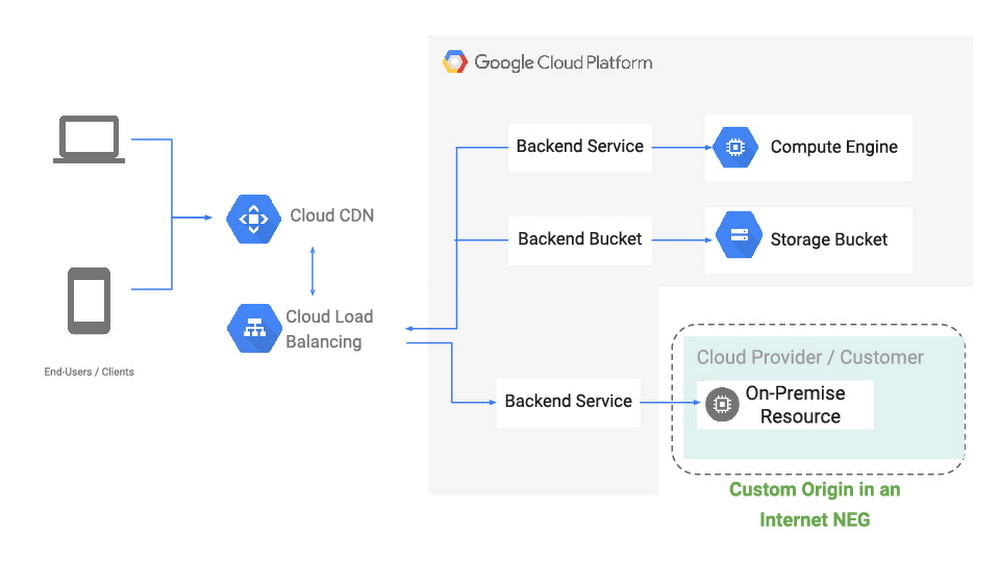Like many Google Cloud customers, you probably have content, workloads or services that are on-prem or in other clouds. At the same time, you want the benefit of high availability, low latency, and convenience of a single anycast virtual IP address that HTTP(S) Load Balancing and Cloud CDN provide. To enable these hybrid architectures, we’re excited to bring first-class support for external origins to our CDN and HTTP(S) Load Balancing services, so you can pull content or reach web services that are on-prem or in another cloud, using Google’s global high-performance network. Introducing Internet Network Endpoint GroupsA network endpoint group (NEG) is a collection of network endpoints. NEGs are used as backends for some load balancers to define how a set of endpoints should be reached, whether they can be reached, and where they’re located. This new hybrid configuration that we’re discussing today are the result of new internet network endpoint groups, which allow you to configure a publicly addressable endpoint that resides outside of Google Cloud, such as a web server or load balancer running on-prem, or object storage at a third-party cloud provider. From there, you can serve static web and video content via Cloud CDN, or serve front-end shopping cart or API traffic via an external HTTP(S) Load Balancer, similar to configuring backends hosted directly within Google Cloud.With internet network endpoint groups, you can:Use Google’s global edge infrastructure to terminate your user connections closest to where users are.Route traffic to your external origin/backend based on host, path, query parameter and/or header values, allowing you to direct different requests to different sets of infrastructure.Enable Cloud CDN to cache and serve popular content closest to your users across the world.Deliver traffic to your public endpoint across Google’s private backbone, which improves reliability and can decrease latency between client and server.Protect your on-prem deployments with Cloud Armor, Google Cloud’s DDoS and application defense service, by configuring a backend service that includes the NEG containing the external endpoint and associating a Cloud Armor policy to it.Endpoints within an internet NEG can be either a publicly resolvable hostname (i.e., origin.example.com), or the public IP address of the endpoint itself, and can be reached over HTTP/2, HTTPS or HTTP.Let’s look at some of the hybrid use cases enabled with internet NEGs:Use-case #1: Custom (external) origins for Cloud CDNInternet NEGs enable you to serve, cache and accelerate content hosted on origins inside and outside of Google Cloud via Cloud CDN, and use our global backbone for cache fill and dynamic content to keep latency down and availability up.This can be great if you have a large content library that you’re still migrating to the cloud, or a multi-cloud architecture where your web server infrastructure is hosted in a third-party cloud, but you want to make the most of Google’s network performance and network protocols (including support for QUIC and TLS 1.3). Use-case #2: Hybrid global load balancingPicking up and moving complex, critical infrastructure to the cloud safely can take time, and many organizations choose to perform it in phases. Internet NEGs let you make the most of our global network and load balancing—an anycast network, planet-scale capacity and Cloud Armor—before you’ve moved all (or even any) of your infrastructure.With this configuration, requests are proxied by the HTTP(S) load-balancer to services running on Google Cloud or other clouds to the services running in your on-prem locations that are configured as an internet NEG backend to your load-balancer. With Google’s global edge and the global network, you are able to deal elastically with traffic peaks, be more resilient, and protect your backend workloads from DDoS attacks by using Cloud Armor. In this first launch of internet NEG, we only support a single non-GCP endpoint. A typical use-case is where this endpoint points to a load-balancer virtual IP address on premises. We are also working on enabling multiple endpoints for internet NEG and health-checking for these endpoints. We will continue to offer new NEG capabilities, including support for non GCP RFC-1918 addresses as load-balancing endpoints. What’s next?We believe hybrid connectivity options can help us meet you where you are, and we’re already working on the next set of improvements to help you make the most of Google’s global network, no matter where your infrastructure might be. You can dive into how to set up Cloud CDN with an external origin or how internet network endpoint groups work in more detail in our Load Balancing documentation. Further, if you’d like to understand the role of the network in infrastructure modernization, read this white paper written by Enterprise Strategy Group (ESG). We’d love your feedback on these features and what else you’d like to see from our hybrid networking portfolio.
Quelle: Google Cloud Platform

Published by